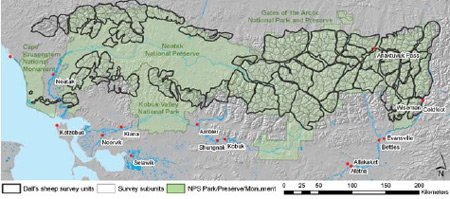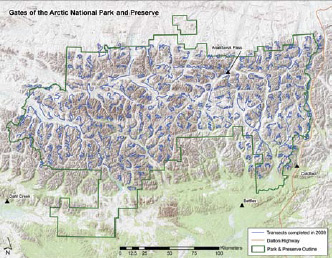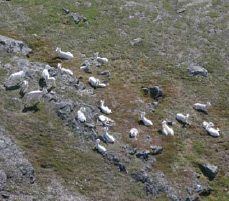Dall’s sheep habitat in the central and western Brooks Range encompasses about 15,800 square miles (41,000 km2), an area roughly twice the size of New Jersey. Monitoring the abundance and distribution of Dall’s sheep in these parklands is a priority for the Arctic Network.

NPS Image
Introduction
A Super Cub airplane ventures into the Brooks Range, its crew searches carefully for one of Alaska’s hardiest inhabitants. The vast, wild character of these Arctic park-lands impresses the pilot and observer as they scan the rugged landscape. Flying along a mountain contour, they spot a group of white dots high on a rocky slope, and, moving closer, are able to identify and count a band of Dall’s sheep.
Dall’s sheep are one of 28 vital signs monitored by the Arctic Network Inventory and Monitoring Program (ARCN I&M) because of their importance to the public and in assessing the overall health of the regional ecosystem. Dall’s sheep are a valued subsistence species for local residents, and sport hunting is permitted in the preserves. They live at the northern limit of their range in these arctic mountains and may serve as a sensitive indicator of environmental change. As a relatively sedentary, alpine species, Dall’s sheep are one of the most visible large mammals for wildlife viewing.
Dall’s sheep habitat in the central and western Brooks Range encompasses about 15,800 square miles (41,000 km2), an area roughly twice the size of New Jersey. Most of this is within Gates of the Arctic National Park and Preserve (Gates of the Arctic), Noatak National Preserve (Noatak) and Kobuk Valley National Park (Kobuk Valley) (Figure 1). Monitoring the abundance and distribution of Dall’s sheep in these parklands is a priority for the Arctic Network, but the immense size and remote nature of this region presents a daunting challenge for designing a statistically valid sampling strategy. Practical considerations, such as accessibility and cost, limit design alternatives that can realistically be implemented.
The central and western Brooks Range likely contained 13-15% of the world’s population of Dall’s sheep in the early 1980s (Valdez and Krausman 1999). An aerial census conducted from 1982 to 1984 estimated a minimum of 10,939 Dall’s sheep in Gates of the Arctic (Singer 1984) and 1,687 sheep in Noatak (Singer et al. 1983). A substantial decline was observed in the late 1980s and early 1990s concurrent with several years of severe winter weather (Shults 2004, Whitten 1997). Although more recent studies indicate a slight recovery and stabilization in some areas (e.g., Shults 2004, Lawler 2004), these numbers remain lower than were observed in the early 1980s. Most of the region has been infrequently or incompletely surveyed since 1984, and previous surveys vary in methodology and success. These inconsistencies prevent park managers from detecting trends in Dall’s sheep abundance in parks, much less on a regional scale.
In 2005 and 2006, the Arctic Network attempted to systematically re-census the central and western Brooks Range by fixed-wing aircraft. Far less area was surveyed than planned, and, in 2007, the survey methods were modified for stratified random sampling. Survey subunits were stratified by sheep density based on the most recent data, and randomly selected for survey order. Data for all three years were analyzed using methods described by Gasaway et al. (1986). Regional abundance estimates (± 95% confidence interval; unadjusted for sightability) were 10,611 +/- 2,533 sheep in 2005-2006 and 7,258 +/-2,710 sheep in 2007 (Rattenbury and Lawler, in prep.). The large variances, lack of current region-wide density data, movement of sheep between subunits, and long ferry times for aircraft make stratified random sampling difficult in this large and remote region. Surveys of large units that require multiple survey days, as were done in 2005 and 2006, are problematic because weather, funding and other logistical constraints may prevent complete coverage. A new strategy was needed to improve the precision of the estimate and to decrease cost and simplify sampling logistics.

NPS Image
Implications for Future Monitoring
The Arctic Network will continue to work with the Central Alaska Network and park biologists to test distance sampling for estimating Dall’s sheep abundance. Surveys with revised methods for generating contour transects are planned for 2010 in Gates of the Arctic, Wrangell-St. Elias, and Lake Clark National Parks and Preserves. If these sur-veys produce satisfactory results, the methods will be ap-plied in Noatak, Kobuk Valley, and Denali National Park and Preserve.
One of the main advantages of distance sampling is the ability to generate abundance estimates for entire park units including estimates of precision and ac-curacy for less cost than a census. Distance sampling also addresses the issue that an unknown proportion of sheep are not seen during aerial surveys by estimating the num-ber of sheep not detected. Moreover, data from multiple survey years can be used to produce density distribution maps. A goal of the Arctic and Central Alaska Network collaboration is to provide survey protocols that can detect park-wide changes in Dall’s sheep abundance and distri-bution.

NPS Photo / Christy Splechter
Acknowledgements
We thank Bill Thompson (Ecologist-Biometrics, Southwest Alaska Network) and Kirmanie Ravariere (GeoNorth LLC) for adapting the NPS Animal Transect Tool for the 2009 sheep survey. We are grateful for the extraordinary efforts of our pilots Andy Greenblatt, Sandy Hamilton, Eric Sieh and Lance Williams, observers Stacia Backensto, Christy Splechter and Tara Whitesell, as well as the technical and logistical support from Paul Atkinson, Scott Miller, Doris Lenahan, Kate Riffey, and the staff in Anaktuvuk Pass, Coldfoot and Bettles. We thank Jim Lawler and Brad Shults for their input in the survey design and review of this article. Funding was provided by the Arctic Network and Gates of the Arctic.
References
Gasaway, W.C., S.D. Dubois, D.J. Reed, and S.J. Harbo. 1986.
Estimating moose population parameters from aerial surveys. Biological Papers, No. 22. University of Alaska.
Lawler, J.P. 2004.
Demography and home ranges of Dall’s Sheep in the Central Brooks Range, Anaktuvuk Pass, Alaska: Gates of the Arctic National Park and Preserve. Technical Report NPS/AR/NRTR-2003. U.S. Department of the Interior, National Park Service. Anchorage, Alaska.
Quang, P.X., and E.F. Becker. 1999.
Aerial survey sampling of contour transects using double-count and covariate data. Pgs 89-97. In Marine mammal survey and assessment methods: Proceedings of the sym-posium on surveys, status and trends of marine mammal populations, edited by A.A. Balkema. Seattle, WA.
Rattenbury, K., and J. Lawler. in prep.
Dall’s Sheep in the Arctic Network Parks, Alaska: Results from Aerial Surveys, 2005- 2007. Technical report. National Park Service.
Shults, B.S. 2004.
Abundance survey of Dall’s sheep in the western Baird Mountains, Alaska, July 2004. Technical Report NPS/AR/NRTR-2004-46. U.S. Department of the Interior, National Park Service. Anchorage, Alaska.
Singer, F.J. 1984.
Aerial Dall sheep count, 1982, 1983, 1984, Gates of the Arctic National Park and Preserve. Natural Resource Survey and Inventory Report AR-84-2. U.S. Department of the Interior, National Park Service. Anchorage, Alaska.
Singer, F.J., D. Johnson, and R. Quimby. 1983.
Dall sheep numbers and distribution in the Noatak National Preserve, 1983. Natural Resource Survey and Inventory Report AR-83/0. U.S. Department of the Interior, National Park Service. Anchorage, Alaska.
Thomas, L., J.L. Laake, S. Strindberg, F.F.C. Marques, S.T. Buckland, D.L. Borchers, D.R. Anderson, K.P. Burnham, S.L. Hedley, J.H. Pollard, J.R.B. Bishop, and T.A. Marques. 2006.
Distance 5.0. Release 2. Research Unit for Wildlife Population Assessment. University of St. Andrews, UK. http://www.ruwpa.st-and.ac.uk/distance/
Valdez, R., and P.R. Krausman. 1999.
Mountain sheep of North America. The University of Arizona Press. Tucson, AZ.
Whitten, K.R. 1997.
Estimating population size and composition of Dall sheep in Alaska: assessment of previously used methods and experimental implementation of new techniques. Federal Aid in Wildlife Restoration Research Final Report, Alaska Department of Fish and Game. Juneau, Alaska.
Part of a series of articles titled Alaska Park Science - Volume 9 Issue 1: Monitoring the "Vital Signs" of Healthy Park Ecosystems .
Last updated: November 1, 2022
